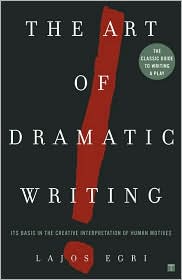
I mentioned a few months back that I had been re-reading The Art Of Dramatic Writing
The first thing you have to deal with in this book is the archaic language, particularly the annoying use of the royal we – as in “For our own use we choose the word ‘premise’” and “As we see it, the basic emotion of Romeo and Juliet is still love.”
The second issue is Egri uses plays as his examples – as you might expect, since it’s a playwriting book. Fortunately they are mostly widely known classics so there’s a good chance you’ve read or seen them. It really helps to at least be familiar with Tartuffe by Moliere and Ghosts by Henrik Ibsen. Egri does provide analyses of these and several other plays in an appendix, so if you’re unfamiliar with them you can still muddle your way through.
It’s also worth noting that Egri was a theater critic, not a playwright. As a result, he’s coming at the writing process by looking at the results and working backwards. If he sees a common problem in plays, he tries to figure out how a writer might avoid that problem. This is certainly a valid perspective, but I wouldn’t take everything he says on faith. A food critic might be able to tell what spice would improve a dish but it doesn’t mean they can teach someone to cook.
Egri begins by emphasizing the importance of what he calls the premise of the play. This is a statement that is to be proved by the story – such as “Jealousy destroys its object.” Functionally, this roughly equates to my idea of the dramatic question – the issue at the heart of the story. I prefer the question approach because it implies two possible outcomes. I fear Egri’s technique is risky because it can encourage on-the-nose and predictable writing. On the other hand, if you do it well there’s nothing really wrong with the premise concept.
Next Egri takes on character. This is the section that really interested me. Egri takes an approach that I oppose – developing character through backstory. But Egri is more in synch with me than he might initially appear. He believes the backstory must be tailored in such a way that the character will ultimately prove the premise. In other words, if your story is about jealousy, then you must create a character that will necessarily become jealous. If the character can avoid this fate, then you’ve failed and must start over.
So Egri is actually doing what I do, which is first figuring out who your character is now, then figuring out how they got there. He’s simply emphasizing the “getting there” more, while I only develop backstory as needed.
Writers and producers talk a lot about making characters “three dimensional.” Usually that’s just a synonym for “complex.” Egri actually defines the three dimensions specifically: physiology, sociology and psychology. He again ties this into creating a character who must behave as needed to prove the premise. I like Egri’s three-dimensional approach a lot. If nothing else, it forces you to think about various aspects of the character’s life you might be ignoring.
The third section of the book is called “Conflict.” Here Egri deals with what we call structure these days. But rather than define specific plot stages, he’s focused more on how the action rises and the character changes. He emphasizes the importance of a steady, step-by-step growth of both story and character. Conflict that goes static or jumps is a failure to him.
Those are certainly valid and useful ideas. But here’s where I feel like we’re in danger with the premise. The conflict may rise consistently and logically, but if it’s so logical the audience can predict everything that’s going to happen from the first scene, how enjoyable is the result? There’s some good food for thought here, but I don’t know if it quite equips the new writer to successfully outline a story. However when used in conjunction with a more modern three act approach, this is some great stuff.
The final section is a catch all for essays on various topics. Many are either dated or playwriting specific. It’s probably the least useful aspect of the book to the modern screenwriter.
As a summary review, I would say there’s a lot of thought provoking stuff on character in The Art of Dramatic Writing, and a few other useful ideas about sustaining momentum. If you’re only going to read one book on screenwriting, this probably isn’t it. But it would make a top ten list for sure.
* * *
In other news, if you're in the L.A. area, I'm going to be co-teaching a one-day seminar on the first ten pages of your screenplay at The Writers Store on October 15. My fellow teachers are Paul Guay (Liar, Liar) and Jeffrey Berman (Magic Beyond Words: The JK Rowling Story). If you sign up by September 30, it's only $149. Here's the link: The First Ten Pages.

2 comments:
I can't find anything to say that Egri was a critic - and he wrote at least half a dozen plays that made it to the stage:
https://en.wikipedia.org/wiki/Lajos_Egri
His main career seems to have been as a teacher of creative writing.
Hi, this page is amazing, i love the ideas and creativity! I also have my own blog and portfolio! It would help me out a lot if you would take a look! thank you! Rhoar. My portfolio Or my blog:
Post a Comment